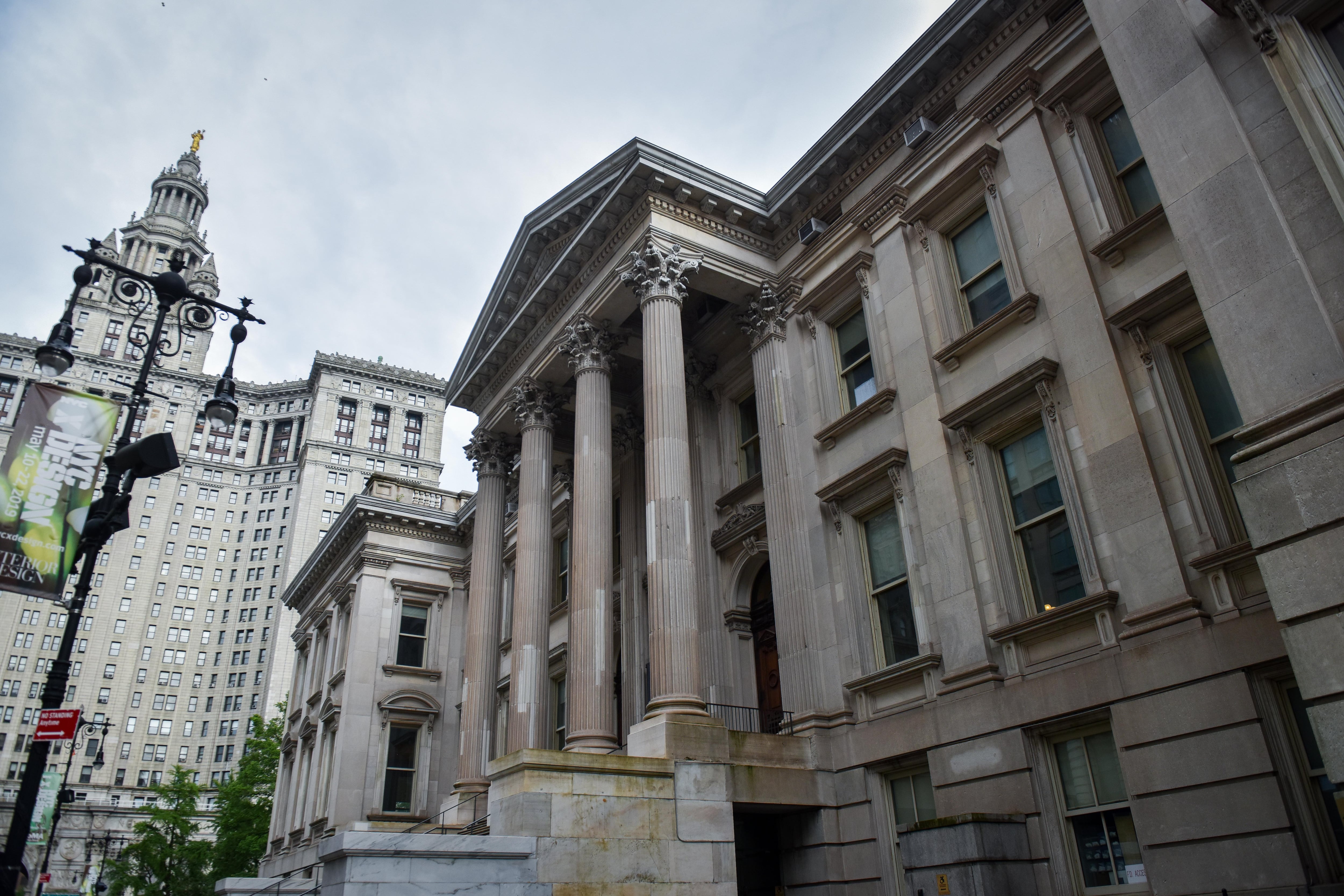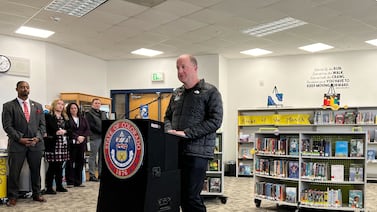Sign up for Chalkbeat New York’s free daily newsletter to get essential news about NYC’s public schools delivered to your inbox.
P.S. 8, a coveted elementary school in Brooklyn Heights, has few options to reduce class sizes to comply with the state’s new law.
The school could try to secure additional space through a new building or annex, or split into multiple sites, but that would take years to complete. The school could get an exemption from the law, but the process for granting waivers is still unclear. And the reality is that most families at the school want lower class sizes, parent leaders say.
So when city officials earlier this year gave schools across New York City the chance to apply for extra funding to reduce class sizes, P.S. 8’s proposal included a request for one thing parent leaders say could make an immediate difference: reducing enrollment.
The school, which currently enrolls about 580 students and operates above 100% of its building capacity, asked to limit kindergarten registration starting next year to students who live in the school’s geographic zone, a change estimated to reduce the overall size of the grade from about 125 to roughly 90, parent leaders said. The school’s principal declined to comment.
At least three other overcrowded schools are also seeking to reduce the size of future incoming classes in order to make progress toward the state mandate, which has a deadline of September 2028 to be in full compliance, families and educators told Chalkbeat. The move would require the schools to keep roughly the same number of teachers — an additional cost because school budgets typically are based on student enrollment.
“This is the only thing we can do,” said the principal of an overcrowded elementary school, on the condition of anonymity because they’re not authorized to talk to the press. The schools are among nearly 500 citywide that officials say do not have space to comply with the mandate.
The requests are notable because the Education Department has so far been reluctant to consider enrollment caps at overcrowded schools as a means of reducing class sizes, even when it’s the most expedient, or realistic, option. Officials have repeatedly expressed concern that reducing enrollment at schools that are maxed out on space — which, by definition, tend to be some of the city’s most in-demand — could anger parents or even drive some to leave the system.
“New enrollment caps are not being considered at this point,” said Education Department spokesperson Jenna Lyle. “New York City Public Schools is continuing to focus on expanding choice and access for families.”
Principals can get some wiggle room on the size of their incoming classes with the approval of their superintendent and the central enrollment office, a spokesperson said, but didn’t share specific criteria for approving those requests.
Officials have signaled that they’re unlikely to commit extra money to help schools seeking to reduce enrollment retain all their teachers. This year’s class size reduction funding aims to support schools to meet the required caps through approaches like filling unused classroom space and hiring more teachers — without reducing their enrollment, Education Department officials said.
Some 750 schools applied for the funding, the city teachers union said.
Right now, just two of P.S. 8’s 25 classes are below the caps set by the law, which limit elementary school classes to 20-23 students, according to Education Department figures.
The school’s enrollment-shrinking proposal, coupled with the extra funding, would allow it to get all five kindergarten classes below the cap, said PTA co-presidents Jennifer LaRusso-Leung and Carol Capece. As those smaller classes move through the school, it would eventually help bring other grades into compliance (though not all before the 2028 deadline).
That’s what most parents in the building want, regardless of the state law, Capece said.
“Our school survey supports this every year,” she said. “Small class sizes is the number one priority for almost all parents at our school.”
The city is nearing a critical phase of the class size law, which passed in 2022. As of last fall, roughly 46% of the city’s classrooms were under the caps. That number has to grow to 60% by this September, and by an additional 20 percentage points each of the two following years.
Education Department officials believe they can reach 60% by supporting schools with the space to comply, but will soon face much tougher decisions about how to handle overcrowded schools.
The stakes are high. The city could lose about $800 million in state funding a year if it fails to comply with the class size law, according to city estimates.
Enrollment caps could be a key tool for crowded schools
Plans like P.S. 8’s were a key component of the recommendations from the city’s class size working group, a committee of dozens of educators, parents, policymakers, and advocates who issued a 2023 report advising the city on how best to comply with the law.
The group concluded that capping enrollment would be a necessary, and relatively cost-effective, tool to help overcrowded schools meet the mandate, but proposed some “guardrails” to minimize the disruption to families.
For instance, they recommended targeting overcrowded schools in close proximity to other schools with excess space, so students affected by the caps would have somewhere close to go, suggesting no more than a 30-minute walk for elementary students.
They also recommended that caps apply only to students who want to attend school out of their zone — an approach that would be quicker and less disruptive than trying to cap zoned enrollment.
Roughly 23% of current kindergartners at overcrowded schools are out-of-zone, and the share is even higher for middle schools and high schools according to the working group. High schools in the city’s choice system are largely unzoned.
The recommendation to pursue enrollment caps was among the most contentious the working group considered, and some members opposed it, arguing that parent choice alone should drive enrollment and urging state legislators to amend the law.
The option, which isn’t favored by the Education Department, is by nature time sensitive: Enrollment caps work best by starting with the lower grades and then moving those smaller classes through the school rather than disrupting existing classes.
“The longer they [the Education Department] wait, the worse it’s going to become,” said Leonie Haimson, the executive director of Class Size Matters, an advocacy group that has pushed for years to lower class sizes, and a member of the working group.
Enrollment caps could have spillover effects
In addition to helping reduce class sizes, enrollment caps could have positive spillover effects citywide, including shoring up enrollment at under-enrolled schools and fostering racial and socioeconomic integration, the working group argued. Overcrowded schools tend to have higher populations of white and Asian American students, while underutilized ones tend to enroll Black and Latino students.
The group acknowledged that in some cases, enrollment caps could undercut diversity efforts by excluding students from underrepresented groups seeking to enroll at a school outside their zone, and members urged the city to consider each case individually.
P.S. 8 is largely white and among the most affluent schools in the city, while its neighboring elementary school in Dumbo, P.S. 307, is largely Black, Latino, and low-income. A controversial rezoning proposal a decade ago that shifted some students previously assigned to the P.S. 8 zone to P.S. 307’s zone drew significant attention and sparked concerns from both schools.
Even though P.S. 8’s current enrollment cap proposal wouldn’t affect zoned families, it will likely disappoint some out-of-zone families hoping to attend the school, Capece acknowledged.
That’s part of why the Education Department has been reluctant to pursue enrollment caps, raising concerns that if fewer families get into their top choice schools, more will leave the system.
When incoming kindergartners get an offer to enroll in their first choice school, roughly 70% of parents accept, and another 21% leave the city or enroll in a charter, according to 2022 data the Education Department shared with the working group. When kindergarten families get an offer at their second or third choice, 37% enroll, 34% leave the public school system, and the remaining families enroll in other city public schools, according to the data.
Enrollment caps alone are unlikely to get the city to 100% compliance with class size caps, the working group acknowledged.
In some districts, especially in southern Brooklyn and Queens, almost all of the schools are overcrowded. In those districts, the only path forward is a big boom in school construction, contends Haimson. But the city’s current construction plans fall well short of those needs, Haimson charged in a December letter to state education officials.
Schools can get exemptions from the law under certain circumstances, including over-enrollment, if the teachers union, principals union, and Education Department all agree. But the specific criteria for those exemptions and the process for deciding on them have not been fully fleshed out.
“The main problem is they have absolutely no plan to provide space either by building more schools or adjusting enrollment between schools,” said Haimson.
Michael Elsen-Rooney is a reporter for Chalkbeat New York, covering NYC public schools. Contact Michael at melsen-rooney@chalkbeat.org.






